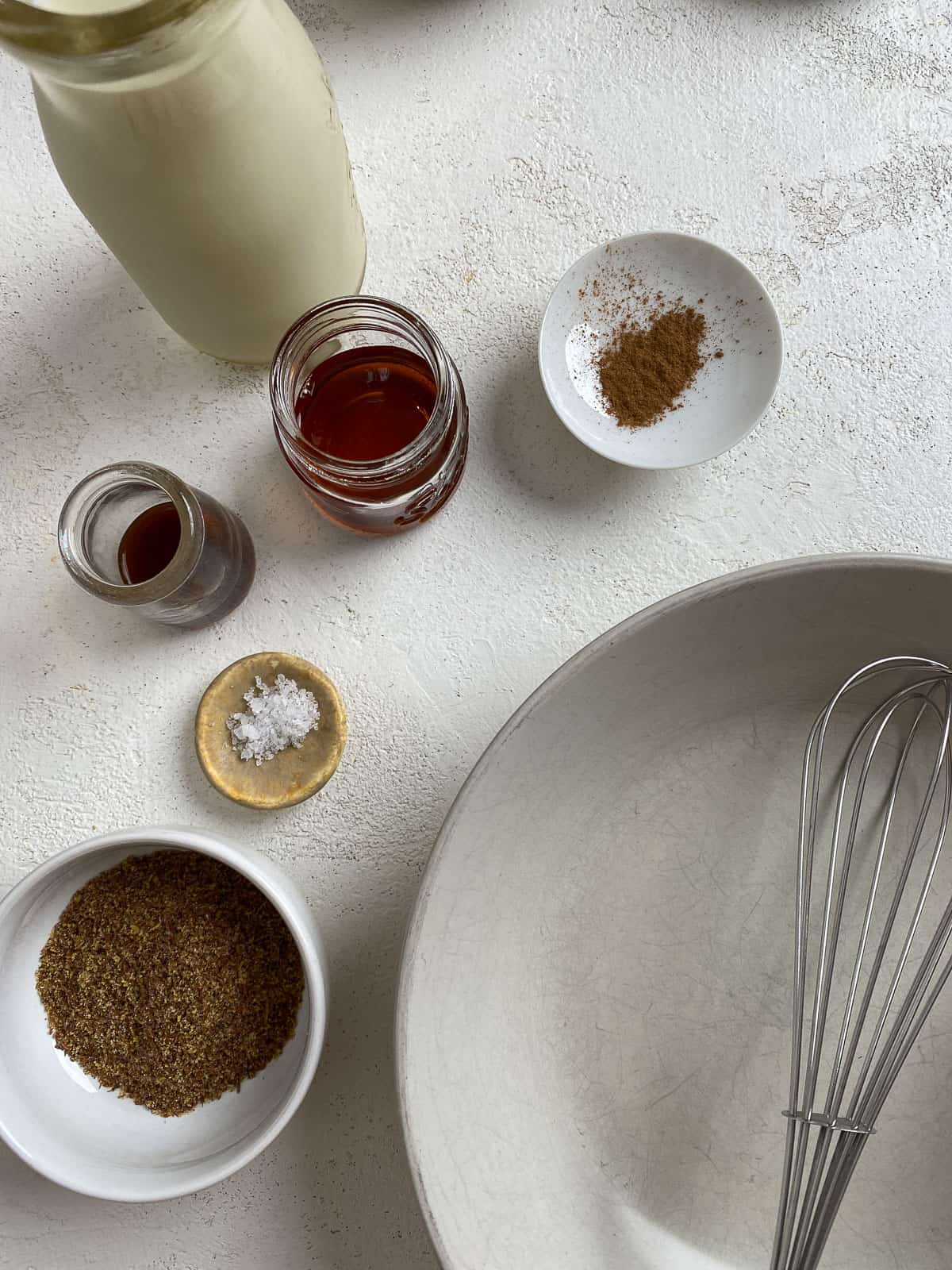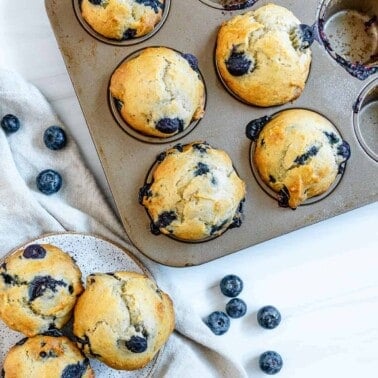As an Amazon Associate I earn from qualifying purchases.
Vegan french toast makes an easy weekend brunch or breakfast that everyone will love. It’s so easy to make this 15-minute french toast without egg by making a few easy swaps.

French toast is one of those breakfast or brunch foods that I usually save for the weekends when there’s more time to spend making breakfast. For a special weekend brunch add some fresh fruit or this yummy blueberry maple syrup and vegan sausage patties.
If you love eggless french toast and need some sweet breakfast inspiration? Check out this Brazilian French toast with bananas and these spinach banana pancakes to take your weekend breakfast up a notch!
Why This Recipe Works
- Weekend treat: French toast is a weekend brunch and breakfast everyone loves.
- Make ahead: Cook a double or triple batch and store to reheat for a quick weekday breakfast.
- Simple ingredients: No surprises here – this french toast without egg uses easy-to-find ingredients.
Ingredients in French Toast Without Egg
This easy vegan french toast uses simple, plant-based ingredients with excellent results.

- Ground flax seed: The egg substitute in this best french toast recipe.
- Plant-based milk: Any type of plant milk works in french toast batter but I really enjoy the natural sweetness found in coconut milk or the nutty flavor of almond milk.
- Agave or maple syrup: Just a touch of sweetness added to the dipping mixture for the bread.
- Vanilla extract and cinnamon: Makes french toast without egg taste even better.
- Bread: Essential to making any type of french toast. You can also use gluten-free if desired!
- Vegan butter: The best choice for cooking french toast.
- Powdered sugar and fresh fruit: Optional but great for serving on top of this simple vegan french toast.
How To Make Vegan French Toast
- 1) Combine the ground flax, plant-based milk, agave or maple syrup, vanilla, salt, and cinnamon in a shallow bowl and whisk until combined.


- 2) Dip each piece of bread on both sides in the batter. Then place immediately in a hot skillet with a little vegan butter.



- 3) Cook on both sides until nice and golden brown.
- 4) Serve it up with a sprinkle of powdered sugar, berries, or cut fresh fruit, jam, or maple syrup.
Expert Tips
- Preheat the pan. A hot pan makes for crisper edges.
- Add some toppings. Jam, maple syrup, coconut whipped cream, powdered sugar, vegan caramel sauce, fresh fruit, and vegan chocolate sauce are all some ideas!
- Enjoy on weekdays too. Follow the instructions to prep ahead so you can enjoy french toast on busy weekdays too!
- Use day-old bread. Which doesn’t get mushy and soft when battered and cooked.
FAQs
Yes, but you will need to replace the egg with another ingredient that will function the same. In french toast, egg creates the batter coating the outside of french toast. In this recipe, flax meal functions as an egg. When it is added to the liquid the flax releases a gel creating a texture much like egg. Chia seeds also work the same way and can be a substitute.
Any type of bread works but depending on the type the end results may be different. When making french toast, you can choose a whole wheat loaf for more fiber or a simple french bread. Also, simple sandwich bread works well too in a pinch but is thinner and cooks up crisper. For best results, a thicker slice works best and day-old bread cooks up better than fresh bread which may be too soft for french toast.

What to Serve with French Toast
Here are some of my favorite ways of serving french toast with flax egg including drinks, toppings, and sides!
- Vegan Date Caramel Sauce
- Vegan Whipped Cream
- Mixed Berry Smoothie
- Cherry Plum Jam
- Vegan Mexican Hot Chocolate
- Tofu Scramble
- Vegan Sausage Patties
- Quinoa Tator Tots
Storage
Whether you have leftovers or make french toast ahead of time, here’s how to store it for the best results.
- Refrigerator: Allow the cooked eggless toast to fully cool and then transfer to an airtight container or freezer bag. Store in the fridge for up to five days.
- Freezer: Store in the same manner and then in the freezer for up to three months.
- Reheat: Lay thawed or frozen cooked french toast on a baking tray and heat in a 350° F oven for 8-10 minutes (thawed) or 10-12 minutes (frozen) or until heated through. Flip over after cooking for five minutes. You can also heat it in an air fryer or microwave.
More Weekend Breakfast Recipes
- Healthy Protein Chocolate Waffles
- Breakfast Quinoa Apple Bowl
- Blueberry Pancakes
- Blueberry Banana Muffins
- Vegan Pumpkin Waffles
Photos by Alfonso Revilla
Easy Vegan French Toast

Video
Ingredients
- 1 ½ Tablespoons of ground flax seed
- ¾ cup of plant-based milk
- 2 Tablespoons of agave or maple syrup
- 1 teaspoon of vanilla extract
- ¼ teaspoon of salt
- ¼ teaspoon of cinnamon
- 3 slices of bread cut in half
- Vegan butter for cooking
- Powdered sugar for garnish (optional)
- Fruit for garnish (optional)
Instructions
- Mix together flax, plant-based milk, agave or maple syrup, vanilla, salt, and cinnamon in a bowl large enough to lay the bread in.
- Coat bread on both sides with the batter then cook in a hot vegan buttered pan. Cook on both sides until nice and golden brown.
- Top with powdered sugar, fruit, maple syrup, etc.
Notes
- Preheat the pan. A hot pan makes for crisper edges.
- Add some toppings. Jam, maple syrup, coconut whipped cream, powdered sugar, vegan caramel sauce, fresh fruit, and vegan chocolate sauce are all some ideas!
- Enjoy on weekdays too. Follow the instructions to prep ahead so you can enjoy french toast on busy weekdays too!












I haven’t had french toast in years and I thought I’d never be able to have it after becoming vegan. So excited for this recipe!
Gotta love veganized classics!
Delicious! Love a good homemade French toast
Same! Such a fun and tasty breakfast idea!
Yum! My favorite weekend breakfast!
Same! So easy and so delicious!
I can’t believe I used to think I’d never have this again! So perfect, like I remember from my childhood!
Such nostalgia! Now you can always enjoy french toast!
Perfect vegan french toast! Can’t wait to make this again this weekend for Sunday brunch!
Hope it’s a hit at brunch too!
I’m loving this vegan french toast! Thanks!
It’s a yummy one!
This is perfect for brunch at home!
Agreed! Simple with a slightly fancy touch!
I’m so happy to share your vegan French toast on my Pinterest. I like my viewers to have choice of different ways to make different foods. Thank you for sharing.
Hope they all enjoy it! It’s a good one!
perfect for sunday brunch!
It’ll definitely be a great hit for brunch!